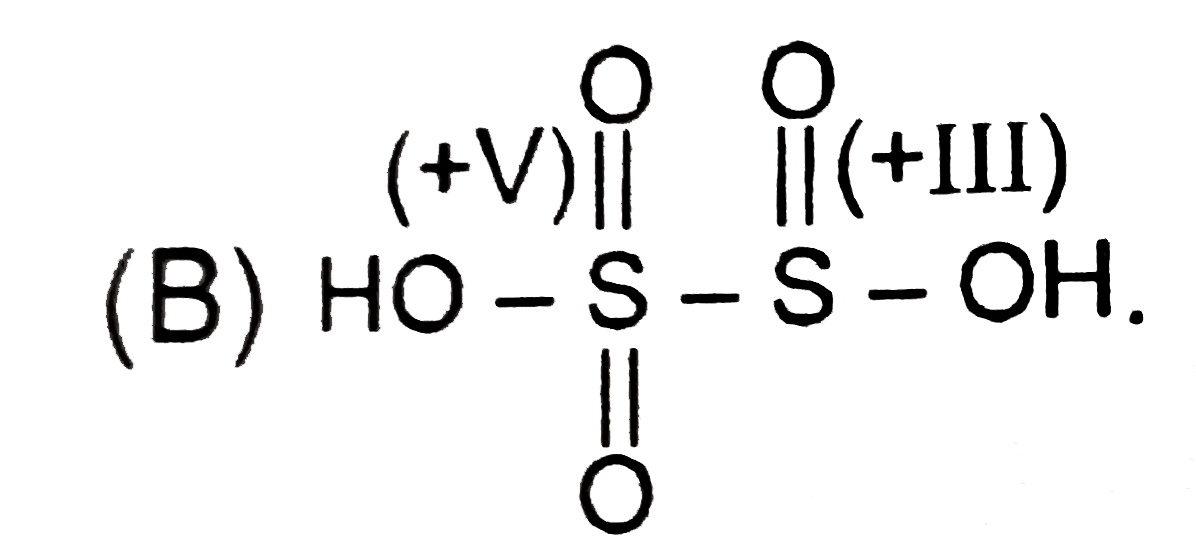Oxygen differs from the other elements of the group. Compounds of oxygen with metals are more ionic in nature and hydrogen bonding is more important for oxygen compounds. Oxygen is never more than divalent beacasue when it hs formed two covalent bonds, there are no low energy orbitals which can be used for form. further bonds. However, the elements S,Se,Te and Po have empty d- orbitals which may be used for bonding, and they can form four or six bonds by unpairing electrons. The higher oxidation states become less stable on decending the group.
The bond between S and O, or Se and O, are much shorter than might be expected for a single bond owing to ρπ−dπ interaction between the p- orbital of oxygen and d- orbital of S or Se.
Which of the following statemet is incorrect ?
Oxo-anions of sulpher have little tendency to pholymerise compared with the phosphates and sillicates.
In pyrosulphurous acid (H2S2O5) the oxidation states of both the sulpher atoms are not same, they are +Vand+III
Concentrated HNO3 oxidises both sulpher and selenium to H2SO4 (+VI)andH_(2) SeO_(4)(+VI) respectively.
Most metal oxides are ionic and basic in nature while non-metallic oxides are usually covalent and acidic in nature.
(A) It is true because of effictive pπ−dπ overlaping owing to small size of sulpher as compared to phosphorous and silicon.
(B) 
They have +V and +III oxidation state.
(C ) HNO3 oxidies sulphur to H2SO4 (+VI) but only oxidies selenium to H2Se3 (+VI). The higher oxidation states become less stable on decending the group.
(D) In M-O electronegativity difference is large while in X-O, it is comparatively smaller (<1.4).
M=meatal and X = non -meatal .
Topper's Solved these Questions
- BOOK - RESONANCE ENGLISHCHAPTER - P BLOCK ELEMENTSEXERCISE - ALP EX #3 OBJECTIVE1videos
P BLOCK ELEMENTS
- BOOK - RESONANCE ENGLISHCHAPTER - P BLOCK ELEMENTSEXERCISE - ALP PART 1 OBJECTIVE100videos
P BLOCK ELEMENTS
- BOOK - RESONANCE ENGLISHCHAPTER - P BLOCK ELEMENTSEXERCISE - PART -III : Match the column2videos
P BLOCK ELEMENTS
- BOOK - RESONANCE ENGLISHCHAPTER - NUCLEAR CHEMISTRYEXERCISE - STAGE-II1videos
NUCLEAR CHEMISTRY
- BOOK - RESONANCE ENGLISHCHAPTER - P-BLOCK ELEMENT (BORON AND CARBON FAMILY)EXERCISE - PART - III : OLYMPIAD PROBLEMS (PREVIOUS YEARS) STAGE - V (INTERNATIONAL CHEMISTRY OLYMPIAD (IChO)) Problem 38videos
P-BLOCK ELEMENT (BORON AND CARBON FAMILY)
Similar Questions
Oxygen differs from the other elements of the group. Compounds of oxygen with metals are more ionic in nature and hydrogen bonding is more important for oxygen compounds. Oxygen is never more than divalent beacasue when it hs formed two covalent bonds, there are no low energy orbitals which can be used for form. further bonds. However, the elements S,Se,Te and Po have empty d- orbitals which may be used for bonding, and they can form four or six bonds by unpairing electrons. The higher oxidation states become less stable on decending the group.
The bond between S and O, or Se and O, are much shorter than might be expected for a single bond owing to ρπ−dπ interaction between the p- orbital of oxygen and d- orbital of S or Se.
Which one of the following orders represents the correct order for the properties indicated against them?View SolutionUnloading of oxygen is relatively more at which of the following areas
View Solution
Knowledge Check
- Question 1 - Select One
The ionisation energy of nitrogen is more than that of oxygen because
AExtra stability of half filled orbitalsBMore number of energy levelsCLess number of valence electronsDSmaller size
Which atom can have more than eight valence electrons when it is forming covalent bonds ?
View SolutionWhich atom can have more than eight valence electrons when it is forming covalent bonds ?
View SolutionCompounds that are formed when metals or non-metals react with oxygen in the air
View SolutionWhich of the following elements can form both ionic and covalent bonds ?
View SolutionThe compound which can form intramolecular hydrogen bond is :
View SolutionCompound formed when hydrogen reacts with oxygen.
View Solution"Hydrogen escapes from the earth's atmosphere more readily than oxygen " why?
View Solution
